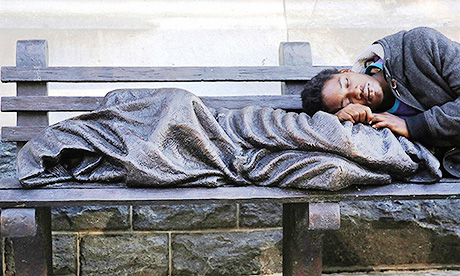Copies of the Homeless Jesus statue have spread around the world in the last eight years. The statue is a life-sized representation of a person lying asleep on a public bench.
The image is the creation of Canadian artist and sculptor Tim Schmalz, who specialises in art addressing religious themes.
He presents the sleeping figure as wrapped tight in a blanket, as if shivering in the cold. The face and hands are not visible but two bare feet stretch out from one end of the blanket.
Both feet are marked with distinctive wounds which are familiar in Christian art.
They show the marks left by the nails during crucifixion.
It is this small detail that shows the figure is a depiction of a suffering Jesus.
Schmalz, a committed Catholic who believes all human life is sacred, was inspired to create the work in 2012 after seeing a homeless man sleeping on a bench in Toronto during the Christmas holidays.
He wanted to invite people to reflect on the parable of judgement in Matthew 25.
In this parable, Jesus tells his disciples, “as you did it to one of the least of my brothers or sisters, you did it to me” (Mattew 25:40).
Schmalz first moulded a clay figure and used this to make a cast to create bronze statues at his studio in Ontario.
He describes it as “essentially a visual translation of one of the core ideas of the Bible”.
We encounter Christ when we encounter others in need.
When we respond to those in need, either offering help or showing indifference, we are responding at the same time to Christ.
Schmalz initially planned to give the statue a face, but decided it would make the figure a more universal representation if he let the blanket act as a hood.
There is a poignant irony in the fact that the statue initially found it hard to find a home.
Two famous Catholic Cathedrals, St Michael’s in Toronto and St Patrick’s in New York, both declined opportunities to purchase it.
This changed in 2013.
Regis College, the Jesuit School of Theology at the University of Toronto, installed the statue in its front plaza.
It serves to invite all who come to the college to reflect on those in need.
In the same year, St Alban’s Episcopal church (Anglican) in Davidson, North Carolina, purchased the first statue to be installed in the United States.
In November 2013, the Pope invited Schmalz to Rome and Schmalz took the model he used to plan the first cast.
The Pope blessed it and described it as a “beautiful and excellent representation” of Jesus.
More and more places then started to request statues in Canada, the US and further afield.
The first statue outside North America was installed in Dublin in April 2015.
In March 2016, a full version was installed outside of the Papal Office of Charities, on the street leading to Saint Peter’s Basilica in Rome.
By this time, about a hundred copies had been installed worldwide, including in Europe, Asia, South America and Australia. One church described having the statue as like offering a “24-hour sermon”.
The statue is so realistic that when it is installed in a new place it often gives passers-by a surprise.
In more than one city, people driving past have mistaken the statue for a real person. Some have called paramedics to give assistance to the sleeping figure.
In some cases, the statue is met with a more hostile response.
In Davidson, a woman who saw the sleeping figure called the police rather than paramedics. It seems that she was worried about the danger to the reputation of the neighbourhood posed by a vagrant.
When she learnt of her mistake she was unmoved.
She said the statue sent the wrong message, and she objected to the idea of Jesus as a vagrant, or in need of help.
Schmalz expected the statue to be provocative and stimulate conversation.
Some have criticised the expense of the statue (about $30,000) and suggested that the money would be better used for people who are actually homeless.
Supporters respond that the statue raises public awareness.
In some places, it serves as a helpful collection focus for donations of food or blankets to support homeless people.
In New Zealand, the Government announced a four-year plan on homelessness in 2019, which it hopes will support those who are living on the streets.
Dunedin’s night shelter is open every day from 6 pm-9 am.
Nonetheless, with the loss of some casual jobs due to Covid, some people can still fall through the gaps in service provision.
As temperatures drop for the winter months sleeping out becomes particularly difficult.
There is no Homeless Jesus statue in Dunedin, but the statues in other cities are a helpful reminder of the message in Matthew 25 to respond to those who are homeless and to treat them and their needs as if they are Christ.
- David Tombs is the Howard Paterson Professor of Theology and Public Issues at the University of Otago.
- First published in the ODT. Republished with permission.
- Image: Pittsburgh Post-Gazette
